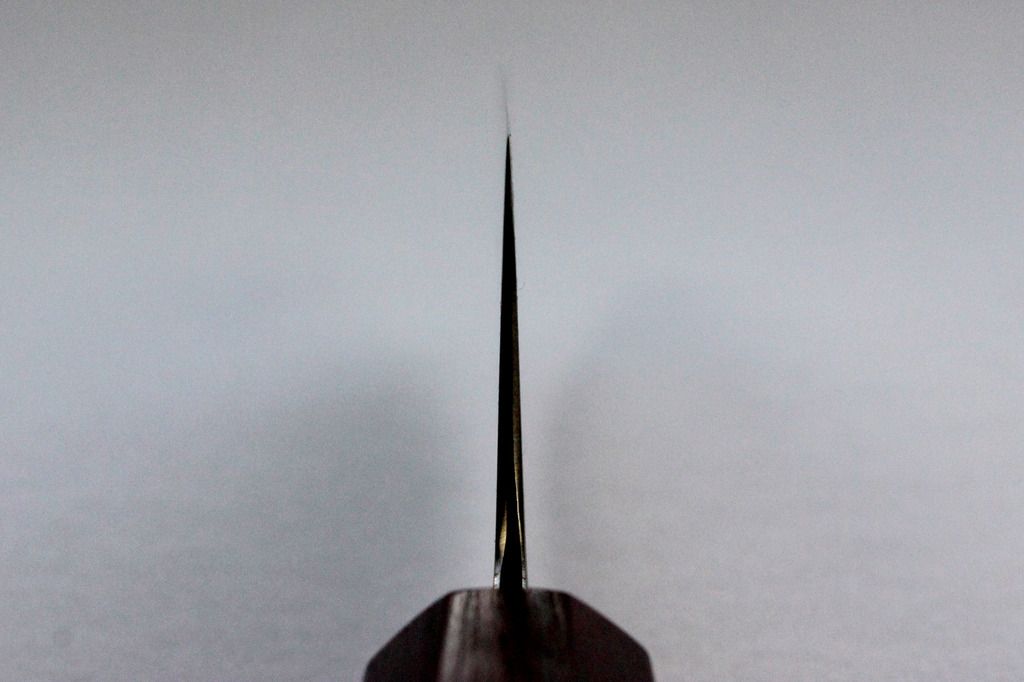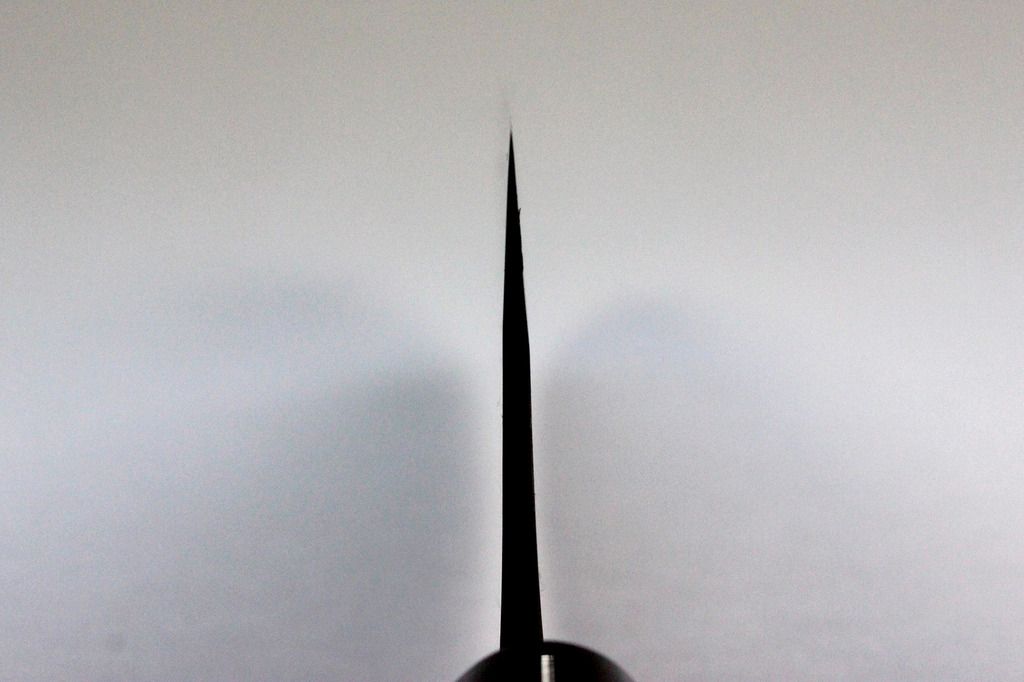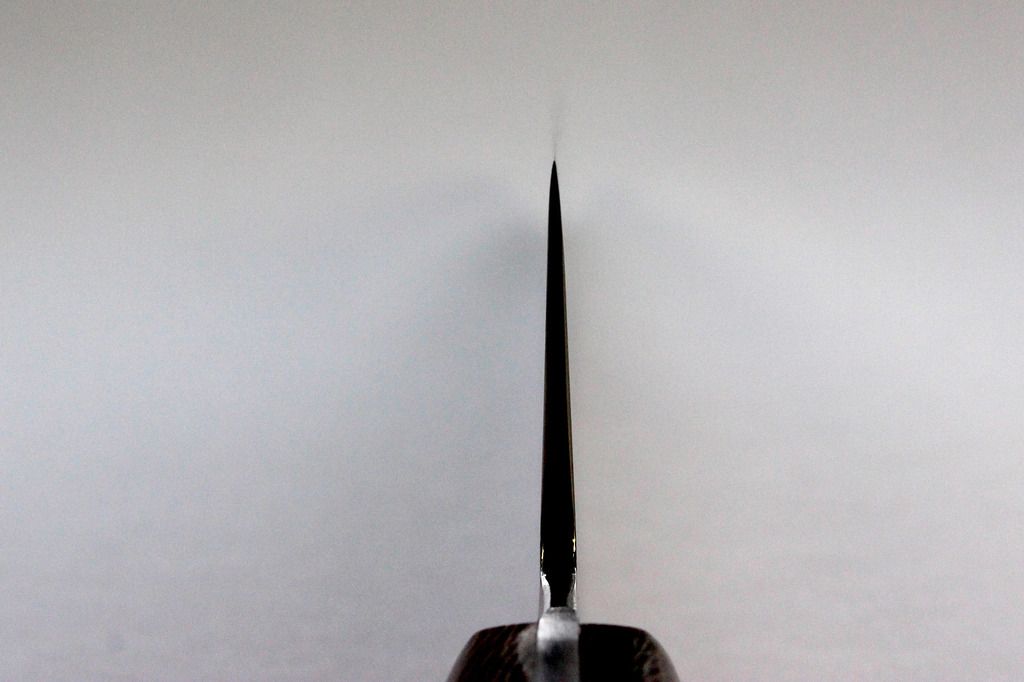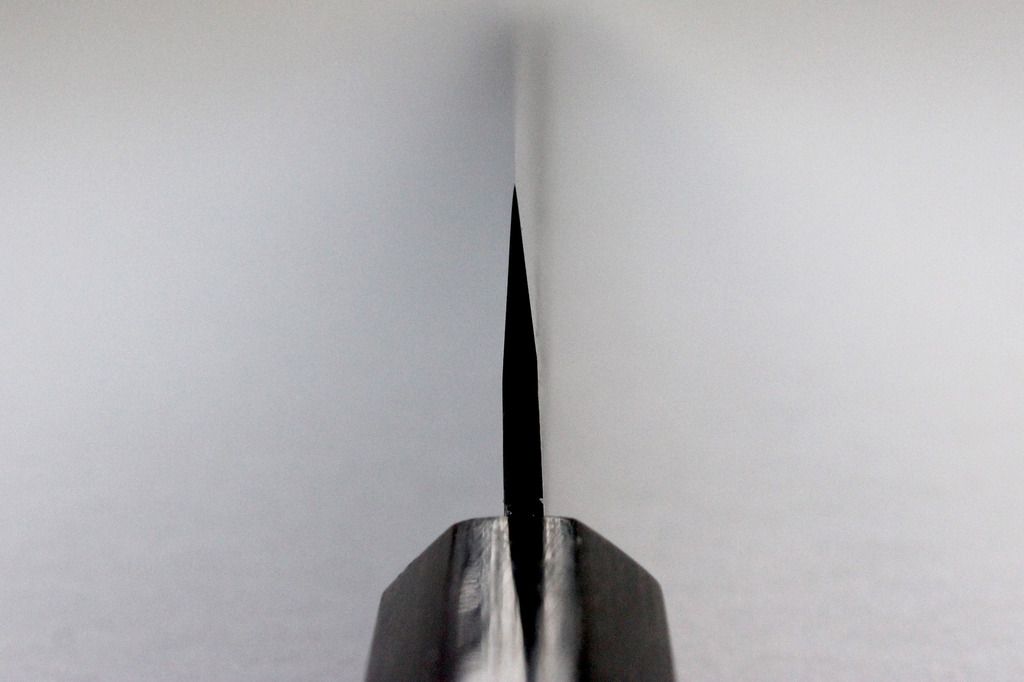What In The World Should I Charge?!
Recent › Forums › Main Forum › Sharpening as a Business › What In The World Should I Charge?!
- This topic has 71 replies, 12 voices, and was last updated 03/23/2015 at 3:15 pm by
Mr.Wizard.
-
AuthorPosts
-
03/21/2015 at 11:39 am #24552
What crucial thing(s) does one need to look for when viewing the cross-sectional/choil shot of a particular knife?
To get back to your question gently pinch the upper part of the knife with the blade aiming between finger & thumb and gentle slide them down to the edge . There should be a smooth transition all the way down from spine to edge that is for slicers gyutus etc this is the crux of the biscuit …An over thinned knife could be the end of the knife which is why it is best to really see how it is faring when you sharpen it the next time. Generally a knife will need thinning a little each time it is sharpened if the spine is fairly thick some knives like lazers or some knives like German ones or Victorinox are flat ground so rarely need thinning .
I would also try cutting something thick to see how the knife performs & how much it needs tweaking.
The edge bevel particularly on thicker knives should not be much more than 1-1.5mm .the next thing to bear in mind is that an appropriately thinned knife should cut deep very easily profile spine to edge for slicers gyutus etc is almost more important than razor sharp.That’s an excellent question and an awesome response, Leo!
I think Leo gave the two most important clues: look at and feel the knife. And cut with it.
When you feel the knife, the transitions should indeed be smooth. However, it is not necessary that knives taper in one straight line from the spine to the edge (full flat ground). There are all sorts of blade grinds that work well, like convex grinds. I tried out an S-grind some time ago and it was awesome: it cut like a dream, but the knife also had good food release. And when you feel/look at it, the blade should be thin above the edge. How thin? That’s indeed a bit of a master’s trick. I tried measuring it, but then the question is where do you measure it? (1 mm above the edge? 2? 5 is already too much.)
So actually using it to cut works best. Try some different types of food. Harder foods like carrots help in telling you whether you thinned the knife enough: it should not wedge. Dense cabbage is also great for this. But also try some onions (great with laser knives), tomatoes (thinness and toothiness), potato slices (food release), peppers and some meat.
The best ground knife is the one that works best!
Molecule Polishing: my blog about sharpening with the Wicked Edge
03/21/2015 at 11:41 am #24553To get back to your question gently pinch the upper part of the knife with the blade aiming between finger & thumb and gentle slide them down to the edge . There should be a smooth transition all the way down from spine to edge that is for slicers gyutus etc this is the crux of the biscuit …An over thinned knife could be the end of the knife which is why it is best to really see how it is faring when you sharpen it the next time. Generally a knife will need thinning a little each time it is sharpened if the spine is fairly thick some knives like lazers or some knives like German ones or Victorinox are flat ground so rarely need thinning .
I would also try cutting something thick to see how the knife performs & how much it needs tweaking.
The edge bevel particularly on thicker knives should not be much more than 1-1.5mm .the next thing to bear in mind is that an appropriately thinned knife should cut deep very easily profile spine to edge for slicers gyutus etc is almost more important than razor sharp.Molecule Polishing: my blog about sharpening with the Wicked Edge
03/21/2015 at 12:09 pm #24554Here are some examples.
A Masakage Koishi as it is ground right from the shop. Pretty thick at the spine, but very thin above the edge. A bit delicate, but it cuts great! No wedging at all, which is marvellous for such a thick knife.
A Carter funyaki. A different blade grind (the blade is also quite thin at the spine), but again thin above the edge and a bit less delicate than the Koishi.
A Watanabee gyuto which I thinned a couple of times. I tried to stay as close to the original (asymmetric) geometry as possible. Very thin at the edge, but not too thin.
Here’s a knife that is in desperate need of thinning :cheer: .
And finally a knife/grind that’s been under discussion quite a lot recently on a kitchen knife forum: a Takeda. I thinned it a couple of times, but kept to the original geometry. The knife is thin enough right behind the edge, but its “shoulders” are quite thick and abrupt. This is a sujuhiki (for proteins), so it is well suited to its purpose. But if you cut carrots with it, it definitely wedges. And it is not great for onions either.
Molecule Polishing: my blog about sharpening with the Wicked Edge
03/22/2015 at 12:30 am #24563Mark,
Thank you for the choil shots! They help for sure.03/22/2015 at 1:23 am #24570Mark,
Here’s a choil shot of random knife that was gifted to me a couple days ago. I’ve seen what inexperienced sharpening on the Edge Pro can do to the tip – weird recurve looking bevel thingy (some of you may know what I’m talking about). I completely reshaped it from heel-to-tip using Cliff’s de-stress method, which is why the edge is flat…
How would you approach this?

~Steven
03/22/2015 at 3:17 pm #24595Steven, I’d say this knife is in need of some serious thinning. Like you did on the Miyabi knife. Or do you mean something else?
Molecule Polishing: my blog about sharpening with the Wicked Edge
03/22/2015 at 6:47 pm #24600Steven, I’d say this knife is in need of some serious thinning. Like you did on the Miyabi knife. Or do you mean something else?
No sir, thinning is what I wondering about.
Awesome! Another project, more practice! :woohoo:03/22/2015 at 8:04 pm #24604😆
Molecule Polishing: my blog about sharpening with the Wicked Edge
03/23/2015 at 1:19 am #24625I think that you should be getting the idea about thinning Mark’s selection of photo were very good .
To recap the transition from spine to edge should be a fairly smooth slope.
What you have to do is lose the technical part of sharpening . Bevel angles and thinning should be based on how the knife looks when you get it back. if for it the edge has lots of micro chips it is possible the bevel angle is too low.If you can see rolls near the edge then the profile may need thickening put the edge perpendicular to the stone.03/23/2015 at 2:14 am #24626the transition from spine to edge should be a fairly smooth slope.
I’m definitely beginning to understand the concept… But, the slope on a knife that is not FFG should be slightly convexed where the flat portion under the spine meets the area being thinned, correct?
If you can see rolls near the edge…
Can you clarify what you mean by rolls near the edge?
03/23/2015 at 1:26 pm #24641Roll damage may occur in small sections of a blade or in a large section as in this image the thin edge area is quite flexible if you push the edge onto the side of a pen or a lighter you can make it flex if it is pushed too far the edge will not flex back this can easily be done when cutting meat with bones in it since many of the bones are curved it will often roll a small area .
So when you inspect a knife you may well see a combination of chips ,breaks (when a rolled part has snapped off)and rolls.Attachments:03/23/2015 at 3:15 pm #24643On a Wusthof? Did someone try to cut rebar with that thing?!
-
AuthorPosts
- You must be logged in to reply to this topic.




